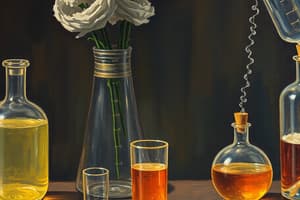Podcast
Questions and Answers
What effect does increasing pressure have on a system at equilibrium?
What effect does increasing pressure have on a system at equilibrium?
- Shifts equilibrium to the side with more molecules.
- Increases the rate at which equilibrium is reached.
- Shifts equilibrium to the side with fewer molecules. (correct)
- Has no effect on the position of equilibrium.
A catalyst changes the position of the equilibrium in a reversible reaction.
A catalyst changes the position of the equilibrium in a reversible reaction.
False (B)
What is the key characteristic of a catalyst that remains unchanged during a chemical reaction?
What is the key characteristic of a catalyst that remains unchanged during a chemical reaction?
It does not undergo any permanent changes.
In heterogeneous catalysis, reaction molecules are _________ onto the surface of the catalyst.
In heterogeneous catalysis, reaction molecules are _________ onto the surface of the catalyst.
Match the following catalysts with their respective applications:
Match the following catalysts with their respective applications:
According to the Maxwell-Boltzmann distribution, how does a catalyst affect the activation energy?
According to the Maxwell-Boltzmann distribution, how does a catalyst affect the activation energy?
At a dynamic equilibrium, the concentration of reactants and products are constantly changing.
At a dynamic equilibrium, the concentration of reactants and products are constantly changing.
State Le Chatelier's principle in a sentence
State Le Chatelier's principle in a sentence
When testing temperature effects on a reaction, cobalt chloride is dissolved in water, then a few drops of ________ are added to the boiling tube before investigation in a cold bath.
When testing temperature effects on a reaction, cobalt chloride is dissolved in water, then a few drops of ________ are added to the boiling tube before investigation in a cold bath.
When adding ammonium hydroxide (NH₄OH) to a solution of yellow potassium chromate (K₂CrO₄) with sulfuric acid, what color change will occur?
When adding ammonium hydroxide (NH₄OH) to a solution of yellow potassium chromate (K₂CrO₄) with sulfuric acid, what color change will occur?
Flashcards
Catalyst
Catalyst
A substance that increases the rate of a reaction without permanent change.
Homogeneous Catalyst
Homogeneous Catalyst
A catalyst that is in the same physical state as the reactants.
Heterogeneous Catalyst
Heterogeneous Catalyst
A catalyst that is in a different physical state than the reactants.
Activation Energy
Activation Energy
Signup and view all the flashcards
Maxwell-Boltzmann Distribution
Maxwell-Boltzmann Distribution
Signup and view all the flashcards
Dynamic Equilibrium
Dynamic Equilibrium
Signup and view all the flashcards
Le Chatelier's Principle
Le Chatelier's Principle
Signup and view all the flashcards
Pressure and Equilibrium
Pressure and Equilibrium
Signup and view all the flashcards
Catalyst and Reaction Pathway
Catalyst and Reaction Pathway
Signup and view all the flashcards
Effects of Temperature on Reaction Rate
Effects of Temperature on Reaction Rate
Signup and view all the flashcards
Study Notes
Experimental Setup
- Boiling water bath set up for heating.
- Boiling tube transferred to it.
- Boiling tube moved back to cold water.
- Starting color: blue.
Catalysis and Equilibrium
- Increasing pressure shifts equilibrium to the side with fewer moles of gas to reduce pressure.
- Catalysts do not change equilibrium position, but instead increase reaction rate.
Catalysts
- Catalyst increases reaction rate without being consumed.
- May react with reactants to form intermediates.
- Provides an alternative pathway with lower activation energy.
Types of Catalysts
- Homogeneous catalyst: Same physical state as reactants (e.g., Cl radicals in ozone depletion).
- Heterogeneous catalyst: Different physical state (e.g., reactions on a surface).
- Reactants adsorb (weakly bind) to the catalyst surface.
- Reaction occurs on the surface.
- Products desorb (leave the surface).
Examples of Heterogeneous Catalysis
- Iron in the Haber process.
- Pt or Rh in reforming.
- Ni in alkene hydrogenation.
- V₂O₅ in sulfuric acid production.
Maxwell-Boltzmann Distribution
- Catalyst effect: Lower activation energy, allowing more molecules to react at a given temperature. Total molecules unchanged. Distribution shape remains similar.
- Without Catalyst:
- Curve starts from zero energy.
- Area under the curve = total number of molecules.
- No maximum molecule energy (curve doesn't hit the x-axis).
- Higher temperatures:
- More molecules exceed activation energy.
- Increased collision rate leads to faster reactions.
- Higher molecular kinetic energy meaning more collisions.
Dynamic Equilibrium & Le Chatelier's Principle
- Dynamic equilibrium: Forward and reverse reaction rates are equal. Reactant and product concentrations remain constant.
- Le Chatelier's principle: Equilibrium shifts to counteract changes.
- More product formation shifts equilibrium to the right.
- More reactant formation shifts equilibrium to the left.
Experimental Procedures - Investigating Concentration Changes
- Starting with yellow K₂CrO₄ solution + dilute H₂SO₄.
- Result: Orange solution.
- Adding NH₄OH turns it back to yellow.
Experimental Procedures - Investigating Temperature Effects
- Cobalt chloride dissolved in water.
- A few drops of HCl added.
- Observing color change in a boiling tube placed in an ice bath.
Studying That Suits You
Use AI to generate personalized quizzes and flashcards to suit your learning preferences.




